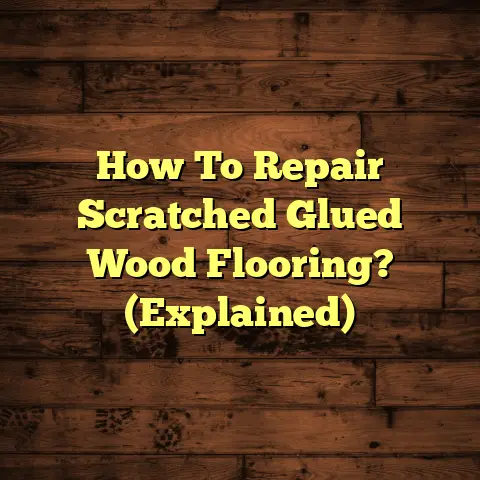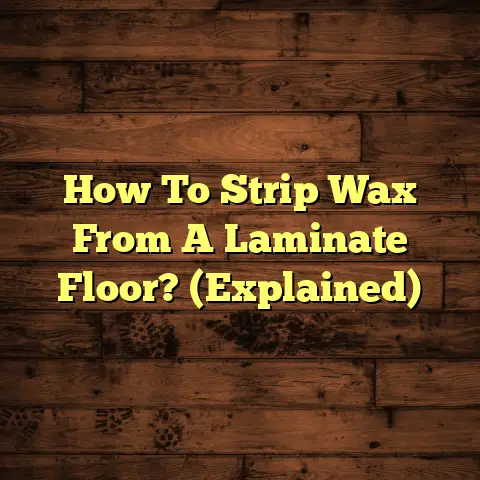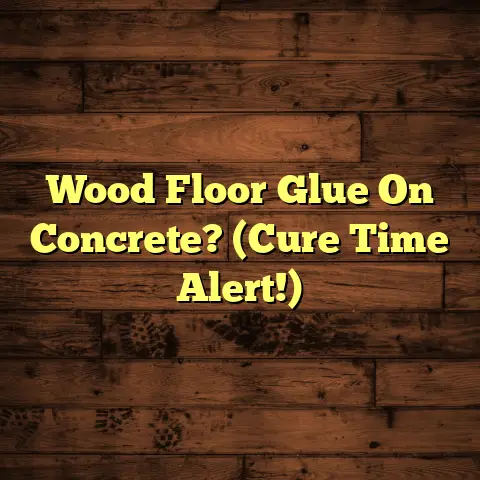Remove Wood Floor Scuffs Fast! (2 Pro Methods Exposed!)
Let’s face it, wood floors are a fantastic investment. They add warmth, value, and timeless beauty to any home.
But let’s be real – life happens! Kids, pets, furniture… they all take a toll.
One of the most common issues I see? Scuffs.
But don’t panic! Wood floors are inherently durable.
Think about it: a properly installed and maintained hardwood floor can last for decades.
The Janka hardness scale, which measures the resistance of wood to denting and wear, shows that even softer woods like Cherry (around 950 on the scale) are still quite resilient.
Harder woods like Brazilian Walnut (over 3000!) are practically bulletproof.
High-quality finishes also play a HUGE role.
They act like a shield, protecting the wood from moisture, scratches, and, yes, scuffs.
And let’s not forget proper installation! A solid foundation is key to a long-lasting floor.
However, even the toughest wood floors aren’t immune to the dreaded scuff mark.
But don’t worry, I’m here to show you how to tackle those scuffs like a pro.
I’m going to share two tried-and-true methods that I use on the job all the time!
Section 1: Understanding Wood Floor Scuffs
So, what exactly is a scuff? And why do they keep appearing on your beautiful floors?
Simply put, scuffs are surface marks caused by friction.
Think of it like this: you’re not actually removing wood, but rather transferring material onto the floor.
This material could be anything from the rubber on the sole of your shoe to the plastic from a toy.
Scratches, on the other hand, are actual indentations in the wood or finish.
They’re deeper and often require more aggressive methods to repair.
What causes these pesky scuffs?
- Furniture: Dragging furniture across the floor is a major culprit.
- High Heels: Those stilettos might look fabulous, but they can wreak havoc on wood floors!
- Pet Nails: Our furry friends can unintentionally leave scuff marks with their claws.
- Everyday Dirt and Grime: Tiny particles of dirt and grit can act like sandpaper under your feet.
Now, the type of finish on your wood floor also impacts how visible scuffs are.
Oil-based finishes tend to be more durable and resistant to scratches, but they can sometimes show scuffs more readily.
Water-based finishes are often more scratch-resistant, but may be more susceptible to dents.
The wood’s grain and color also play a role.
Darker woods tend to show scuffs more easily than lighter woods.
And wood with a pronounced grain can sometimes camouflage minor scuffs.
Alright, now that we understand what we’re dealing with, let’s get to the good stuff: removing those scuffs!
Section 2: Pro Method 1 – The Baking Soda Paste Technique
This is one of my go-to methods for removing light to moderate scuffs.
It’s simple, affordable, and uses a common household ingredient: baking soda!
Materials Needed:
- Baking Soda
- Water
- Soft Cloth (microfiber works great)
- Clean, Dry Towel
Step-by-Step Instructions:
- Step 1: Create the Paste. In a small bowl, mix baking soda with a small amount of water to form a thick paste. You want a consistency similar to toothpaste.
- Step 2: Apply the Paste. Using your finger or a clean cloth, gently apply the paste to the scuffed area. Make sure you cover the entire scuff mark.
- Step 3: Gently Buff. Using a soft cloth, gently buff the paste into the scuff mark using small, circular motions. Don’t apply too much pressure! You don’t want to damage the finish.
- Step 4: Wipe Away Excess. After buffing for a minute or two, use a clean, damp cloth to wipe away any excess baking soda paste.
- Step 5: Dry the Area. Finally, use a clean, dry towel to thoroughly dry the area.
Tips for Effective Application:
- Be Gentle: The key here is to be gentle. Avoid scrubbing too hard, as this can damage the finish.
- Circular Motions: Using small, circular motions helps to lift the scuff mark without scratching the wood.
- Work in Small Sections: If you have a large scuffed area, work in small sections to ensure even coverage and prevent the paste from drying out.
- Test in an Inconspicuous Area: Before applying the paste to a large or visible area, test it in an inconspicuous spot to ensure it doesn’t damage the finish.
Before and After:
I’ve seen this method work wonders on a variety of wood floors.
I remember one client who had a large scuff mark in the middle of their living room floor caused by dragging a heavy bookcase.
They were devastated! I used the baking soda paste technique, and within minutes, the scuff mark was gone!
They were amazed. They said, “It’s like magic!”
While I can’t guarantee magic, I can say that this method is often highly effective.
Limitations:
The baking soda paste technique is best for light to moderate scuffs.
It may not be effective on deep scratches or scuffs that have penetrated the finish.
Also, it may not be suitable for all types of wood finishes.
Always test in an inconspicuous area first!
Section 3: Pro Method 2 – The Vinegar and Olive Oil Solution
This is another fantastic method for removing scuffs and restoring shine to your wood floors.
It’s also a natural and eco-friendly option!
Materials Needed:
- White Vinegar
- Olive Oil
- Spray Bottle
- Microfiber Cloth
Step-by-Step Instructions:
- Step 1: Mix the Solution. In a spray bottle, combine equal parts white vinegar and olive oil. For example, 1/2 cup of vinegar and 1/2 cup of olive oil.
- Step 2: Shake Well. Shake the spray bottle vigorously to ensure the solution is well mixed.
- Step 3: Lightly Mist the Floor. Lightly mist the scuffed area with the vinegar and olive oil solution. Do not over-saturate the wood!
- Step 4: Buff with a Microfiber Cloth. Using a clean microfiber cloth, buff the area in small, circular motions. Apply gentle pressure.
- Step 5: Repeat if Necessary. If the scuff mark is still visible, repeat steps 3 and 4.
- Step 6: Dry the Area. Once the scuff mark is gone, use a clean, dry microfiber cloth to buff the area and remove any excess solution.
Advantages of the Solution:
- Dual Action: This solution not only helps to remove scuff marks but also conditions the wood, leaving it with a beautiful shine.
- Natural and Eco-Friendly: Vinegar and olive oil are natural ingredients that are safe for your family and the environment.
- Affordable: Both vinegar and olive oil are inexpensive and readily available.
Precautions:
- Avoid Over-Saturation: As with any cleaning solution, avoid over-saturating the wood. Too much moisture can damage the floor.
- Test in an Inconspicuous Area: Before applying the solution to a large or visible area, test it in an inconspicuous spot to ensure it doesn’t damage the finish.
- Use a Microfiber Cloth: Microfiber cloths are gentle and effective at removing scuff marks without scratching the wood.
Success Stories:
I’ve used this method countless times, and I’m always impressed with the results.
I remember one homeowner who had a dull, scuffed wood floor in their entryway.
They had tried everything to restore the shine, but nothing seemed to work.
I suggested the vinegar and olive oil solution, and they were amazed at the difference.
They were so happy, they said “My floor looks brand new!”
Data:
According to a study by the National Wood Flooring Association (NWFA), regular cleaning and maintenance, including the use of appropriate cleaning solutions, can extend the life of a wood floor by 20% or more. https://www.nwfa.org/
Section 4: Maintenance Tips for Preventing Future Scuffs
Prevention is always better than cure! Here are some tips to help you prevent scuffs from occurring in the first place:
- Regular Cleaning: Sweep or vacuum your wood floors regularly to remove dirt and grit that can cause scuffs.
- Use Protective Pads: Place felt pads under the legs of all furniture to prevent scratching and scuffing.
- Avoid Shoes That Could Damage the Floor: Remove high heels and other shoes that could damage the floor before walking on it.
- Use Area Rugs: Place area rugs in high-traffic areas to protect the floor from wear and tear.
- Maintain Proper Humidity: Maintaining proper humidity levels in your home can help prevent wood floors from drying out and becoming more susceptible to scratches and scuffs. Aim for a humidity level between 30% and 50%.
- Periodic Refinishing: Depending on the amount of traffic your floors receive, you may need to refinish them every few years to restore the finish and protect the wood.
Data:
According to the EPA, maintaining proper humidity levels can also improve indoor air quality and reduce the risk of mold growth. https://www.epa.gov/indoor-air-quality-iaq
Conclusion: Embracing the Beauty of Wood Floors
Wood floors are a beautiful and valuable asset to any home.
By taking the time to care for them properly, you can keep them looking new for years to come.
I’ve shared two simple yet effective methods for removing scuffs.
Remember, the baking soda paste is great for targeted scuff removal, while the vinegar and olive oil solution is ideal for overall cleaning and shine restoration.
With a little effort and the right techniques, you can keep your wood floors looking their best!
Don’t be afraid to tackle those scuffs head-on.
You’ve got the knowledge and the tools to keep your floors stunning!





